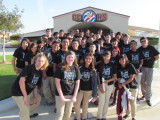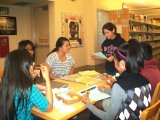-
Category 2
Selected in 2012
-
Grades: 9 - 12
School Setting: rural
Town Population: 53,000
Student Enrollment: 1,420
Student Demographics:
Black/African American: 1%
Teacher/Student Ratio: 1:25
White/Caucasian: 3%
Hispanic: 85%
Hawaiian/Pacific Islander: 0%
Asian: 1%
Native American: 0%
Other: 10%
% Reduced Lunch: 100%
% ELL Learners: 38%
Founded: 2003 -
PRINCIPAL:
Ben DeLeon -
CONTACT:
800 Browning Road
Delano, CA 93215
661-720-4502
bdeleon@djuhsd.org
Cesar E. Chavez High School
Delano, CA
We do not hold with those who claim that demographics dictate destiny; we believe that every student, regardless of their personal background and academic preparation, can succeed and excel at our school. We believe this is true for all students, including English Learners and Socio-economically Disadvantaged students. We believe this not only as a philosophical proposition; we believe it because we see it happen every day at Cesar E. Chavez High School.
- Describe specific programs in place to ensure that families are involved in the success of your school and students.
-
We have several programs that include Parent Project, PIQUE, ELAC, DELAC, and School Site Council. One we are working on establishing is here soon is though McGraw-Hills OnBoard online AP program. Besides helping prepare students for AP courses and exams, there will be a component designed to give parents information on what to expect as they assist their student’s path toward college.
Also, we are proud to have partnered with UC Merced and the Parent Empowerment Program. The Parent Empowerment Program (PEP) was established in 2004 through a grant from the California Student Aid Commission and EdFund. Its primary purpose is to empower parents to clearly, unequivocally understand how to help their children navigate the myriad issues related to financing higher education and matriculating to a college or university.
The Parent Empowerment Program has allowed the Center for Educational Partnerships to fulfill its goal of supplementing student and school-centered activities with parental interventions that influence the extent to which parents support their student’s matriculation at baccalaureate-granting institutions. The Parent Empowerment Program also seeks to increase Cal Grant applicant and recipient rates at targeted schools through this effort.
At the heart of the Parent Empowerment Program: Parental interventions based on an eight-session curriculum focusing on higher-education matters. Since 2004, the Parent Empowerment Program has served 1,349 parents at 17 schools. As part of this curriculum, 985 parents have also participated on campus visits to 19 colleges/universities. These interventions serve families who do not fully support their students’ desires to enroll at a postsecondary institution because of deeply rooted cultural values - Describe the most successful activity your school has initiated to strengthen the ties to your community.
- We have several activities that have strengthened our ties to our community. Everything from food drives, relay for life, Cesar E. Chavez Day of Service, to our Winter Wonderland event, these efforts by our school community and students have yielded a vibrant relationship with our community. We are proud of our service learning record and our partnership with the Cesar E. Chavez Foundation, Community Connections, and the Community Alliance of Delano, California.
- Describe your philosophy of school change or improvement.
- Our philosophy of school change and improvement stems from our convction that when you believe, "si se puede" (yes we can). However, as with all institutions and organizations, everything rises and falls on leadership. Having said that, my personal philosopy is anchored in "The Five Practices and Ten Commitments of Exemplary Leadership" as described in Kouzes and Pozner’s book, The Leadership Challenge. They include: 1) Model the Way; a. Find Your Voice by clarifying your personal values. b. Set the Example by aligning actions with shared values.; 2) Inspire a Shared Vision; a. Envision the Future by imagining exciting and ennobling possibilities. b. Enlist others in a common vision by appealing to shared aspirations.; 3) Challenge the Process; a. Search for Opportunities by seeking innovative ways to change, grow, and improve. b. Experiment and take risks by constantly generating small wins and learning from mistakes.; 4) Enable Others to Act; a. Foster Collaboration by promoting cooperative goals and building trust. b. Stengthen Others by sharing power and discretion. 5) Encourage the Hear; a. Recognize contributions by showing appreciation for individual excellence. b. Celebrate the Values and Victories by creating a spirit of community.
- What are your school’s top two goals for the next year?
-
Focusing on improving and expanding in the following areas:
1) College Readiness: a. increase the percentage of students taking and completing A-G requirements; b. increasing participation in SAT/ACT. c. Increasing the passing rates on AP exams.
2) Career Pathways/ CTE - strengthen current pathways and expand to provide students with more choices that would prepare them for a 21st century technical world (ex. Multi-Media-Video Production, Music-Performance-Drama, Business-Finance, Engineering and Design, etc.) - What is the single most important factor in the success of your school that others could replicate?
- At Cesar E. Chavez High School, we embrace the challenge of closing the academic achievement gap. We do not hold with those who claim that demographics dictate destiny; we believe that every student, regardless of their personal background and academic preparation, can succeed and excel at our school. We believe this is true for all students, including English Learners (EL) and Socio-economically Disadvantaged (SES) students. We believe this not only as a philosophical proposition; we believe it because we see it happen every day at Cesar E. Chavez High School. Beginning in 2003, when CCHS students first arrived on our new campus, we have shaped a school culture that fosters, recognizes, and celebrates student achievement, and we have structured programs that overcome existing academic deficits and meet the real immediate needs of each student. At Cesar E. Chavez High School, the spirit of high expectations is more than an attitude; it defines our family of educators; it is ingrained in our school culture; and it is reflected in the habits and practices of our professional learning community, yielding real, tangible, positive results for our students and our community.
- Describe the program or initiative that has had the greatest positive effect on student achievement.
-
One of the first programs established was the Targeted Almost Proficient (TAP) program. TAP was initiated to provide targeted instruction and remediation for EL students, in particular, and any student who was found to be near proficient/near passing on the 9th grade portion of the California Standards Tests (CST) in Mathematics and English-Language Arts (ELA). It was anticipated that, with some specific and targeted remediation, students could make the jump from basic to proficient. The ultimate goal for all students, including our TAP students, is to ensure they attain mastery of grade level standards and to build academic confidence allowing them to make post-secondary education a reality. (Figures 1 and 2)
The current TAP program has four main components.
• All EL students are monitored for academic progress throughout the year, and a sub-group of these students, identified through multiple diagnostic measures (see below), are strategically targeted for an intense 10 week after school program that focuses on mastering ELA CAHSEE standards and a Math CAHSEE Academy held on Saturday focusing on Mathematics CAHSEE standards. The process for identifying the students is multifaceted including a diagnostic test, teacher recommendation, and a regression line that correlates 9th grade CST scores as predictors of 10th grade CAHSEE scores.
• The curriculum is individualized through a software program called Revolution. This software assigns tutorials and homework based on the diagnostic assessment results and aids the teacher in evaluating and meeting every student’s individual needs.
• TAP students are strategically grouped during the regular school day into TAP English and TAP math classes. The TAP English and math classes are based on the regular curriculum, but all students in these classes meet the almost proficient/passing criteria. Thus, the goal of these TAP classes is to increase student awareness and responsibility as well as allowing for targeted strategic instruction using Explicit Direct Instruction (EDI) methodology by the teacher.
• The TAP program aims to positively shape the academic culture by placing strategic focus on raising students’ expectations to achieve proficiency on the CAHSEE rather than simply passing it. This is accomplished by establishing specific incentives and special recognition awards for high achievement and growth.
A surprising, unanticipated result has been a school wide academic culture shift where many students’ sense of responsibility for personal academic achievement has been increased in all academic areas such as Advanced Placement tests, ACT tests, and other college readiness indices. (Figure 3)
As our school culture continued to evolve, it became apparent that afterschool tutorial sessions would have to be overhauled in order to continue closing the gap for our students, namely our EL and SES students. Thus Afterschool Academic Intervention Programs were initiated starting in 2009-2010. Currently, our afterschool academic interventions are offered in four parts, each designed for remediation/intervention of students with deficiencies in study habits, foundational skills in math or English, or motivation. The following is a summary of each session:
1. Afterschool Tutorial: Any student can voluntarily attend tutorial sessions after school in math, English, science, or social science 2 to 4 days each week. Students receive assistance on homework, enrichments, projects, or any questions they may have by tutorial teachers in each department.
2. Mandatory Afterschool Academic Study Hall (MAASH): Students who fail 3 or more classes during the previous 5 week grading period are assigned MAASH. Students are given time and assistance in completing daily homework assignments or the assigned daily reading assignment for the Titan Accelerated Reader Program. Students can exit at the next 5 week grading period if all grades are C’s or better AND if the student submits a weekly routing slip showing, 90% attendance, and acceptable daily behavior. A counselor is assigned to monitor attendance and progress.
3. Mandatory Afterschool Academic Tutorial (MAAT): Students who need extra time for completing homework, making up missing assignments or requiring supervised time to complete assignments are electronically assigned MAAT daily by teachers. Parents are notified via Connect-Ed telephone notification.
4. Mandatory Afterschool Daily/Weekly Detention (MADD/MAWD): All students in grades 9-10 are assigned a two week reading goal via the Titan Accelerated Reader Program. Any student who fails to complete their reading by the deadline is assigned MADD until they are caught up. Parents are notified via Connect-Ed telephone notification.
In the Spring of 2011, CCHS was awarded as a California Distinguished School. In 2012, CCHS was named again as a Title I Academic Achievement Award winner. In 2009 and 2011, CCHS was named by U.S. News and World Report as one of America’s Top High Schools (Bronze Medal) and in 2012 CCHS achieved Silver Medal status. Among similar schools, CCHS has also received a ranking of 10 and a 98% pass rate on the CAHSEE. - Explain how Title I funds have supported your improvement efforts.
- Title I funds have funded our: A) PLC efforts at: 1) Aligning Curriculum and Assessments to State Standards; 2) Analyzing Data; 3) Creating and adjusting formative assessments; B) Targeted Academic Interventions for SES students both during the day, afterschool, summer, and weekends.
- Identify the professional development activities you use to improve the teaching portion of the teaching and learning process.
- In-service training is offered annually on EDI, SDAIE, ELD, Differentiation, and AVID methodologies.
- Describe how data is used to improve student achievement and inform decision making.
- Our PLC model, where core subject level cohorts meet regularly, allows for teachers to mine and analyze data frequently looking for patterns and trends that assist them in making informed decisions regarding formative assessments, instructional strategies, and curriculum. Under the direction of our Learning Director, department chairs and resource teachers identify strengths and weaknesses in our curriculum, instruction, and assessment and then develop plans to implement adjustments meant to improve student achievement.
- Describe your school culture and explain changes you’ve taken to improve it.
- Since our inception in 2003, our motto has been, "CCHS is a Professional Learning Community, a school where learning and academic achievement is fostered, recognized, and celebrated." Through the vision and guidance of our Academic Culture Committee, a committee made up of certificated and classified staff and students, our culture has evolved into one that exudes pride in maintaining and valuing academic excellence. Our students understand what it means to be a Titan and the high expectations all stakeholders believe in. We go out of our way to acknowledge success and celebrate excellence through venues like "Salute to Scholars Night", "Student of the Month" socials, and Top Scholar incentives and rewards that include "Titan Bucks", to Top Scholar T-Shirts, and so on.
Stats
-
Category 2
Selected in 2012
-
Grades: 9 - 12
School Setting: rural
Town Population: 53,000
Student Enrollment: 1,420
Student Demographics:
Black/African American: 1%
Teacher/Student Ratio: 1:25
White/Caucasian: 3%
Hispanic: 85%
Hawaiian/Pacific Islander: 0%
Asian: 1%
Native American: 0%
Other: 10%
% Reduced Lunch: 100%
% ELL Learners: 38%
Founded: 2003 -
PRINCIPAL:
Ben DeLeon -
CONTACT:
800 Browning Road
Delano, CA 93215
661-720-4502
bdeleon@djuhsd.org










